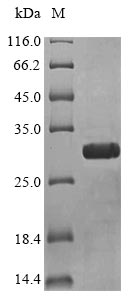Recombinant Oxyuranus microlepidotus Toxin 3FTx-Oxy6 is expressed in E. coli and includes the full length of the mature protein, specifically the 22-81 amino acid region. The protein carries an N-terminal 10xHis-SUMO tag along with a C-terminal Myc tag to aid purification and detection. SDS-PAGE analysis shows it reaches greater than 85% purity, which appears to provide high-quality material for research applications.
3FTx-Oxy6 comes from the venom of the Inland taipan, one of the world's most venomous snakes. This protein belongs to the three-finger toxin family, which is known for disrupting cellular functions. Toxinology researchers find it particularly interesting due to its potential effects on ion channels and receptors. This makes it a valuable tool for studying neurotoxicity and related pathways, though the exact mechanisms may still require further investigation.
Potential Applications
Note: The applications listed below are based on what we know about this protein's biological functions, published research, and experience from experts in the field. However, we haven't fully tested all of these applications ourselves yet. We'd recommend running some preliminary tests first to make sure they work for your specific research goals.
Oxyuranus microlepidotus Toxin 3FTx-Oxy6 is a three-finger toxin that requires precise folding, proper disulfide bond formation (typically 4-5 conserved disulfide bonds), and specific tertiary structure for its neurotoxic activity. The E. coli expression system cannot provide the eukaryotic folding environment or oxidative conditions necessary for correct disulfide bond formation. The dual N-terminal 10xHis-SUMO tag (∼15 kDa) and C-terminal Myc tag (∼1.2 kDa) are extremely large relative to the small toxin size (∼7 kDa mature protein), creating severe steric interference that will disrupt the toxin's functional domains and binding interfaces. The probability of correct folding with functional activity is extremely low.
1. Biochemical Characterization and Structural Studies
Basic biophysical characterization can be performed, but will not reflect native toxin structure. The massive tags will dominate the protein's physical properties, making techniques like dynamic light scattering primarily measure tag behavior. Circular dichroism may detect secondary structure, but cannot verify functional disulfide bonding.
2. Antibody Development and Immunological Research
This application has limited utility. While antibodies can be generated, the immune response will primarily target the large foreign tags rather than the small toxin domain. Antibodies may not recognize conformational epitopes of the native, disulfide-bonded toxin.
Final Recommendation & Action Plan
This dual-tagged toxin construct is fundamentally unsuitable for functional research due to severe steric interference from the massive tags relative to the small toxin size. The combined tags (∼16 kDa) are more than twice the size of the toxin itself (∼7 kDa), making functional studies biologically irrelevant. Limited to basic physical characterization of the tagged protein (Application 1) and generating antibodies against linear epitopes (Application 2). For legitimate toxin research, use tag-free toxin produced by chemical synthesis or eukaryotic expression systems that support proper disulfide bond formation.






